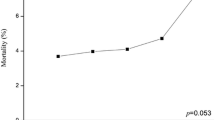Abstract
To study the safety and efficacy of the thrombolytic agent saruplase as a bolus, the angiographic and clinical outcomes of three bolus regimens were investigated in a pilot study conducted in 192 patients with an acute myocardial infarction and were compared with the standard regimen. Fifty-two patients received a double bolus of 40 mg and 40 mg after 30 minutes, 51 patients a bolus of 80 mg, and 36 patients a bolus of 60 mg. Fifty-three patients received the standard regimen (a bolus of 20 mg and 60 mg IV infusion over 1 hour). At 60 minutes TIMI 2 and 3 flow were, respectively, 9.6% and 61.5% with the 40/40-mg bolus, 15.7% and 51.0% with the 80-mg bolus, 16.7% and 30.6% with the 60-mg bolus, and 7.5% and 54.7% with the standard 20/60-mg infusion. At 90 minutes TIMI 2 and 3 flow improved to 9.6% and 73.1%, 15.7% and 56.9%, 13.9% and 36.1%, and 5.7% and 71.7%, respectively. The primary endpoint, persistent patency (TIMI 2 + 3) at 24–45 hours, was seen in 69.2%, 64.7%, 44.4%, and 67.9% of patients who had no rescue PTCA, respectively. Inclusion in the 60-mg bolus group was prematurely stopped because of their low patency rates. The 40/40-mg bolus group had the highest mortality rate (13.5%), whereas the 60-mg bolus group had no deaths. Other adverse event rates were similar in the four groups. This clinical outcome is highly influenced by rescue PTCA of patients with insufficient TIMI flow. This pilot study indicates that in patients with an acute myocardial infarction, a double bolus of 40/40 mg resulted in the highest patency but also had the highest complication rate. The 80-mg single bolus is an attractive alternative for further evaluation because of its acceptable patency and event profile, and its easy form of administration.
Similar content being viewed by others
References
PRIMI Trial Study Group. Randomized double-blind trial of recombinant pro-urokinase against streptokinase in acute myocardial infarction. Lancet 1989;1:863–868.
Bär FW, Meyer J. Vermeer F, et al. Early patency and reocclusion: Comparison of saruplase and alteplase in acute myocardial infarction. From the SESAM study. Am J Cardiol 1997;79:727–732.
Michels R, Hoffmann H, Windler J, Barth H, Hopkins G. A double-blind multicentre comparison of the efficacy and safety of saruplase in the treatment of acute myocardial infarction. Report of the SUTAMI study group. Thrombos Thrombolys 1995;2:117–124.
Tebbe U, Windeler J, Boesl I, Massberg I, Barth H on behalf of the LIMITS Study Group. Thrombolysis with recombinant unglycosylated single chain urokinase-type plasminogen activator (saruplase) in acute myocardial infarction: Influence of heparin on early patency rate (LIMITS study). J Am Coll Cardiol 1995;26:365–373.
Tebbe U, Michels R, Adgey J. et al. Thrombolysis with saruplase is at least as effective in AMI as streptokinase: COMPASS double-blind study in 3089 patients. J Am Coll Cardiol 1996;166A:752–751.
Vermeer F, Bär FW, Windeler J, Schenkel W. Saruplase, a new fibrin specific thrombolytic agent. Final results of the PASS study (1698 patients) (abst). Circulation 1993;88:292.
Relik-van Wely L, Visser RF, van der Pol J, et al. Angiographically assessed coronary arterial patency and reocclusion in patients with acute myocardial infarction treated with anistreplase: Results of the Anistreplase Reocclusion Multicentre Study (ARMS). Am J Cardiol 1991;68:296–300.
Bonnier HJRM, Visser RF, Klomps HC, et al. Comparison of intravenous anisoylated plasminogen streptokinase activator complex and intracoronary streptokinase in acute myocardial infarction. Am J Cardiol 1988;62:25–30.
Mathey DG, Schofer J, Sheehan FH, Becher H, Tilsner V, Dodge HT. Intravenous urokinase in acute myocardial infarction. Am J Cardiol 1985;55:878–882.
Rossi P, Bolognese L. Comparison of intravenous urokinase plus heparin versus heparin alone in acute myocardial infarction. Am J Cardiol 1991;68:585–592.
Purvis JA, McNeil AJ, Siddiqui RA, et al. Efficacy of 100 mg of double-bolus alteplase in achieving complete perfusion in the treatment of acute myocardial infarction. J Am Coll Cardiol 1994;23:6–10.
Gemmill JD, Hogg KJ, MacIntyre PD, Booth N, Rea AP, Dunn FG, Hillis WS. A pilot study of the efficacy and safety of bolus administration of alteplase in acute myocardial infarction. Br Heart J 1991;66:134–138.
Lincoff AM, Topol EJ. Illusion of reperfusion. Does anyone achieve optimal reperfusion during acute myocardial infarction? Circulation 1993;87:1792–1805.
Karagounis LA, Sorensen SG, Menlove RL, Moreno F, Anderson JL. Does thrombolysis in myocardial infarction (TIMI) perfusion grade 2 represent a mostly patent artery or a mostly occluded artery? Enzymatic and electrocardiographic evidence from the TEAM 2 study. J Am Coll Cardiol 1992;19:1–10.
Anderson JL, Karagounis LA, Becker LC, Sorensen SG, Menlove RL. TIMI perfusion grade 3 but not grade 2 results in improved outcome after thrombolysis for myocardial infarction. Ventriculographic, enzymatic and electrocardiographic evidence from the TEAM 3 study. Circulation 1993;87:1829–1839.
Vogt A, von Essen R, Tebbe U, Feuerer W, Appel KF, Nauhaus KL. Impact of early perfusion status of the infarctrelated artery after thrombolysis for acute myocardial infarction: Retrospective analysis of four German multicentre studies. J Am Coll Cardiol 1993;21:1391–1395.
Ohman EM, Califf RM, Topol EJ, et al. Consequences of reocclusion after successful reperfusion therapy in acute myocardial infarction. Circulation 1990;82:781–791.
Author information
Authors and Affiliations
Rights and permissions
About this article
Cite this article
Bär, F., Meyer, J., Boland, J. et al. Bolus Administration of Saruplase in Europe (BASE), a Pilot Study in Patients with Acute Myocardial Infarction. J Thromb Thrombolysis 6, 147–153 (1998). https://doi.org/10.1023/A:1008809907268
Issue Date:
DOI: https://doi.org/10.1023/A:1008809907268




